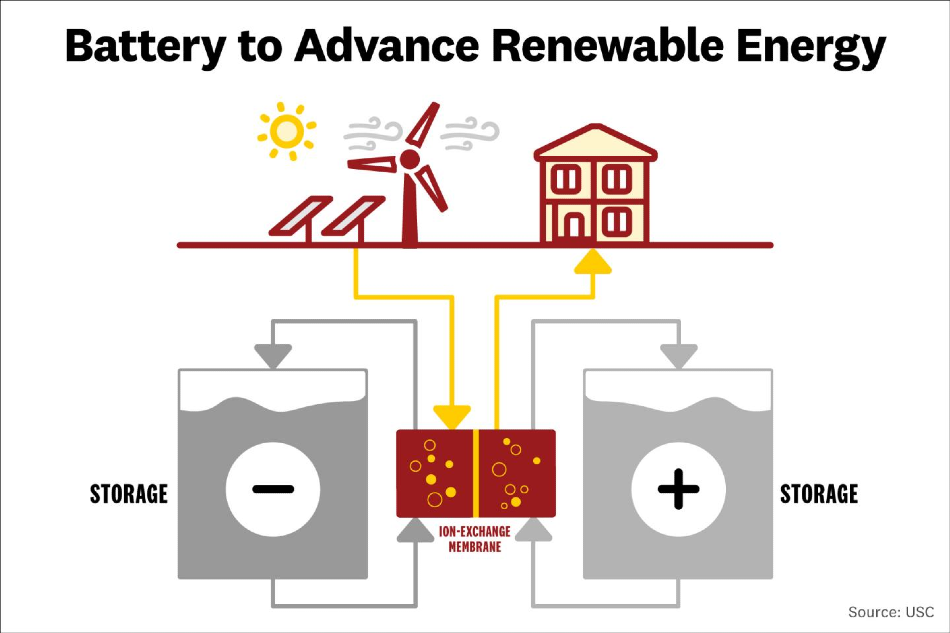Apr 10 2020
A novel battery designed by researchers at the University of Southern California (USC) could resolve the electricity storage issue that restricts the extensive use of renewable energy.
 How the redox flow battery works. Image Credit: University of Southern California.
How the redox flow battery works. Image Credit: University of Southern California.
The new technology is the latest twist on a well-known design that involves storing electricity in solutions, sorting the electrons, and liberating power when it is required. The so-called redox flow batteries have been around for some time, but the USC scientists have developed an improved version based on affordable and readily available materials.
We have demonstrated an inexpensive, long-life, safe and eco-friendly flow battery attractive for storing the energy from solar and wind energy systems at a mass-scale."
Sri Narayan, Chemistry Professor and Co-Director, Loker Hydrocarbon Research Institute, University of Southern California
Narayan is the lead author of the study that was recently published in the Journal of the Electrochemical Society.
One of the major obstacles faced by renewable power is energy storage since power demand does not always coincide when sunshine reaches solar panels or wind turbines spin. The quest for a feasible storage solution has been hampered by several difficulties, which is the issue that the USC researchers wanted to resolve.
The focus of the team was on the redox flow battery since it is an established technology and has been deployed in a few applications to date. Fluids are used for storing electrochemical energy, sorting electrons and recombining through oxidation and reduction, and discharging them to generate electricity when it is required.
The main innovation realized by the researchers was the use of different fluids: a type of acid and an iron sulfate solution. Iron sulfate is a waste product of the mining sector, which is affordable and abundant. Anthraquinone disulfonic acid (AQDS) is an organic material used in a few redox flow batteries for its solubility, steadiness, and energy storage potential.
Although the two compounds are famous separately, for the first time they have been combined to demonstrate the potential for large-scale energy storage. The tests carried out at the USC laboratory proved the battery has huge benefits over competitors.
For instance, iron sulfate is copious and inexpensive—2.2 pounds can be bought for a dime—while large-scale manufacturing of AQDS would cost around $1.60 for each pound. At such a cost, material expenses for the kind of battery designed by the USC researchers would be $66/kWh; if produced at scale, electricity would cost less than half the energy extracted from the redox batteries that make use of vanadium, which is more toxic and costly.
Moreover, in the tests carried out at USC, the scientists discovered that the iron-AQDS battery can recharge or cycle hundreds of times with practically no power loss, in contrast to competing technologies. In the case of energy storage systems, durability is crucial for large-scale use.
The materials developed are highly sustainable. AQDS can be manufactured from any carbon-based feedstocks, including carbon dioxide. Iron is an earth-abundant, non-toxic element."
Surya Prakash, Study Co-Author and Director, Loker Hydrocarbon Research Institute, University of Southern California
Prakash works with Narayan to create new organic quinones.
The technology is also more beneficial compared to lithium-ion battery storage. The increase in electric vehicles and consumer electronics, driven by lithium-ion batteries, has led to the scarcity of the element, which increases the costs. According to the study, those economics make alternative, low-cost energy storage options more attractive.
Moreover, lithium-ion batteries do not last for a long time as a result of recharging, which is familiar to a majority of the people who have recharged laptops and cellphones.
According to the researchers, “The iron-AQDS flow battery system presents a good prospect for simultaneously meeting the demanding requirements of cost, durability and scalability for large-scale energy storage.”
Although the use of renewable energy is increasing, it is constrained as a result of energy storage restrictions. Storing only about 20% of today’s wind and solar energy needs a reserve capacity of 700 GWh. One gigawatt-hour of electricity is sufficient to power about 700,000 homes per hour.
To date, there has been no economically viable, eco-friendly solution to energy storage that can last for 25 years. Lithium-ion batteries do not have the long-life and vanadium-based batteries use expensive, relatively toxic materials limiting large-scale use. Our system is the answer to this challenge. We foresee these batteries used in residential, commercial and industrial buildings to capture renewable energy."
Sri Narayan, Chemistry Professor and Co-Director, Loker Hydrocarbon Research Institute, University of Southern California